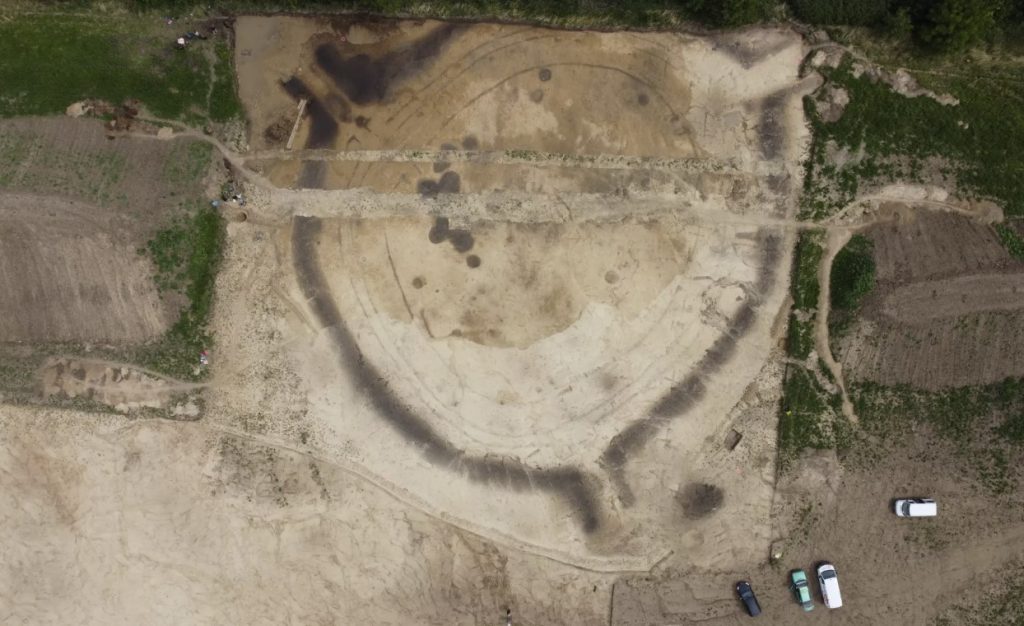
Archaeologists digging near Prague have discovered the remains of a Stone Age structure that’s older than Stonehenge and even the Egyptian pyramids: an enigmatic complex known as a roundel.
Nearly 7,000 years ago during the late Neolithic, or New Stone Age, a local farming community may have gathered in this circular building, although its true purpose is unknown.
Get ready! You should always have your emergency kit ready…
The excavated roundel is large — about 180 feet (55 meters) in diameter, or about as long as the Leaning Tower of Pisa is tall, Radio Prague International reported.
And while “it is too early to say anything about the people building this roundel,” it’s clear that they were part of the Stroked Pottery culture, which flourished between 4900 B.C. and 4400 B.C., Jaroslav Řídký, a spokesperson for the Institute of Archaeology of the Czech Academy of Sciences (IAP) and an expert on the Czech Republic’s roundels.
StrangeSounds.org has been banned from ad networks and is now entirely reader-supported CLICK HERE TO SUPPORT MY WORK…
Miroslav Kraus, director of the roundel excavation in the district of Vinoř on behalf of the IAP, said that revealing the structure could give them a clue about the use of the building.
Researchers first learned about the Vinoř roundel’s existence in the 1980s, when construction workers were laying gas and water pipelines, according to Radio Prague International, but the current dig has revealed the structure’s entirety for the first time. So far, his team has recovered pottery fragments, animal bones and stone tools in the ditch fill, according to Řídký.
Carbon-dating organic remains from this roundel excavation could help the team pinpoint the date of the structure’s construction and possibly link it with a Neolithic settlement discovered nearby.
Prepare now! Protect your home and cars againts EMP, solar flare and lightnings…
The people who made Stroked Pottery ware are known for building other roundels in the Bohemian region of the Czech Republic, Řídký said. Their sedentary farming villages — located at the intersection of contemporary Poland, eastern Germany and the northern Czech Republic — consisted of several longhouses, which were large, rectangular structures that held 20 to 30 people each. But the “knowledge of building of roundels crossed the borders of several archaeological cultures,” Řídký noted. “Different communities built roundels across central Europe.”
Roundels were not well-known ancient features until a few decades ago, when aerial and drone photography became a key part of the archaeological tool kit. But now, archaeologists know that “roundels are the oldest evidence of architecture in the whole of Europe,” Řídký told Radio Prague International earlier this year.
StrangeSounds.org has been banned from ad networks and is now entirely reader-supported CLICK HERE TO SUPPORT MY WORK…
A trench wall revealing stratigraphy (different layers) of the excavation.
Viewed from above, roundels consist of one or more wide, circular ditches with several gaps that functioned as entrances. The inner part of each roundel was likely lined with wooden poles, perhaps with mud plastering the gaps, according to Radio Prague International. Hundreds of these circular earthworks have been found throughout central Europe, but they all date to a span of just two or three centuries. While their popularity in the late Neolithic is clear, their function is still in question.
In 1991, the earliest known roundel was found in Germany, also corresponding to the Stroked Pottery culture. Called the Goseck Circle, it is 246 feet (75 m) in diameter and had a double wooden palisade and three entrances. Because two of the entrances correspond with sunrise and sunset during the winter and summer solstices, one interpretation of the Goseck Circle is that it functioned as an observatory or calendar of sorts, according to a 2012 study in the journal Archaeological Papers of the American Anthropological Association.
Řídký preferred a more general interpretation of the Vinoř structure, noting that “roundels probably combined several functions, the most important being socio-ritual,” he told Live Science. It is likely that roundels were built for gatherings of a large number of people, perhaps to commemorate events important to them as a community, such as rites of passage, astronomical phenomena or economic exchange.
Prepare now! Stock up on Iodine tablets for the next nuclear disaster…
Given that the people who built roundels had only stone tools to work with, these roundels’ sizes are quite impressive — most commonly, about 200 feet (60 m) in diameter, or half the length of a football field. But little is known about the people themselves, as very few burials have been found that could provide more information about their lives seven millennia ago.
After three centuries of popularity, roundels suddenly disappeared from the archaeological record around 4600 B.C. Archaeologists do not yet know why the roundels were abandoned. But considering over one-quarter of all roundels found to date are located in the Czech Republic, future research similar to the excavation at Vinoř may eventually help solve the mystery of the roundels. [Radio Prague, Live Science]














Been working on this site since the 1980’s?….As usual in archeology, some old guys had to die for the older date to surface; they probably knew the date after the first month of work.
In 1980, it was communist country. Nothing happened then.
“The Stroked pottery Culture” what? so in 300,000 years of modern humans they only started stroking a bit of clay a few thousand years ago? yeah right.
Roundel? I get it. It’s ROUND!
Guesswork is fun work. The more scientific estimate of the pyramids’ and Sphynx age is 10,000 BC or earlier.
Agreed.
Thunderdome.